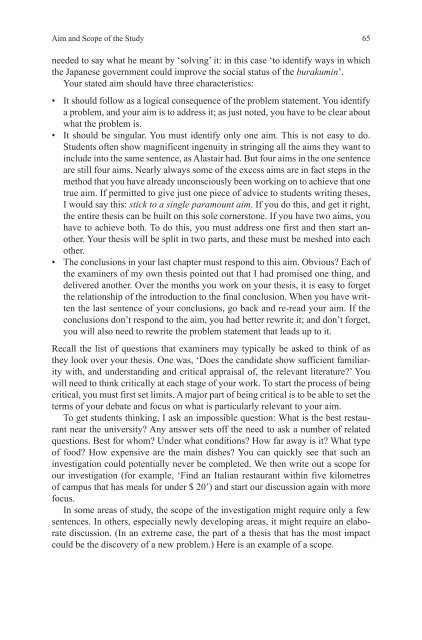How-to-Write-a-Better-Thesis
Create successful ePaper yourself
Turn your PDF publications into a flip-book with our unique Google optimized e-Paper software.
Aim and Scope of the Study<br />
65<br />
needed <strong>to</strong> say what he meant by ‘solving’ it: in this case ‘<strong>to</strong> identify ways in which<br />
the Japanese government could improve the social status of the burakumin’.<br />
Your stated aim should have three characteristics:<br />
• It should follow as a logical consequence of the problem statement. You identify<br />
a problem, and your aim is <strong>to</strong> address it; as just noted, you have <strong>to</strong> be clear about<br />
what the problem is.<br />
• It should be singular. You must identify only one aim. This is not easy <strong>to</strong> do.<br />
Students often show magnificent ingenuity in stringing all the aims they want <strong>to</strong><br />
include in<strong>to</strong> the same sentence, as Alastair had. But four aims in the one sentence<br />
are still four aims. Nearly always some of the excess aims are in fact steps in the<br />
method that you have already unconsciously been working on <strong>to</strong> achieve that one<br />
true aim. If permitted <strong>to</strong> give just one piece of advice <strong>to</strong> students writing theses,<br />
I would say this: stick <strong>to</strong> a single paramount aim. If you do this, and get it right,<br />
the entire thesis can be built on this sole corners<strong>to</strong>ne. If you have two aims, you<br />
have <strong>to</strong> achieve both. To do this, you must address one first and then start another.<br />
Your thesis will be split in two parts, and these must be meshed in<strong>to</strong> each<br />
other.<br />
• The conclusions in your last chapter must respond <strong>to</strong> this aim. Obvious? Each of<br />
the examiners of my own thesis pointed out that I had promised one thing, and<br />
delivered another. Over the months you work on your thesis, it is easy <strong>to</strong> forget<br />
the relationship of the introduction <strong>to</strong> the final conclusion. When you have written<br />
the last sentence of your conclusions, go back and re-read your aim. If the<br />
conclusions don’t respond <strong>to</strong> the aim, you had better rewrite it; and don’t forget,<br />
you will also need <strong>to</strong> rewrite the problem statement that leads up <strong>to</strong> it.<br />
Recall the list of questions that examiners may typically be asked <strong>to</strong> think of as<br />
they look over your thesis. One was, ‘Does the candidate show sufficient familiarity<br />
with, and understanding and critical appraisal of, the relevant literature?’ You<br />
will need <strong>to</strong> think critically at each stage of your work. To start the process of being<br />
critical, you must first set limits. A major part of being critical is <strong>to</strong> be able <strong>to</strong> set the<br />
terms of your debate and focus on what is particularly relevant <strong>to</strong> your aim.<br />
To get students thinking, I ask an impossible question: What is the best restaurant<br />
near the university? Any answer sets off the need <strong>to</strong> ask a number of related<br />
questions. Best for whom? Under what conditions? <strong>How</strong> far away is it? What type<br />
of food? <strong>How</strong> expensive are the main dishes? You can quickly see that such an<br />
investigation could potentially never be completed. We then write out a scope for<br />
our investigation (for example, ‘Find an Italian restaurant within five kilometres<br />
of campus that has meals for under $ 20’) and start our discussion again with more<br />
focus.<br />
In some areas of study, the scope of the investigation might require only a few<br />
sentences. In others, especially newly developing areas, it might require an elaborate<br />
discussion. (In an extreme case, the part of a thesis that has the most impact<br />
could be the discovery of a new problem.) Here is an example of a scope.














![[Lonely Planet] Sri Lanka](https://img.yumpu.com/59845622/1/169x260/lonely-planet-sri-lanka.jpg?quality=85)


